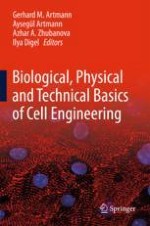2018 | OriginalPaper | Chapter
Stem Cells: Cellular and Extracellular Requirements for Generation and Use
Authors : Gerd Bungartz, Kathryn Bungartz
Published in: Biological, Physical and Technical Basics of Cell Engineering
Publisher: Springer Singapore
Activate our intelligent search to find suitable subject content or patents.
Select sections of text to find matching patents with Artificial Intelligence. powered by
Select sections of text to find additional relevant content using AI-assisted search. powered by
